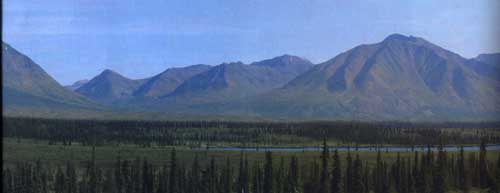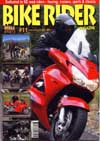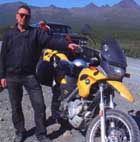|
This is Part 2 of a two-part series written by Stephan
Cross, a New Zealand rider who joined us on our Prince
William Sound Camp Tour the first week of August, 2002.
He wrote the article for a Kiwi-based motorcycle
magazine call Bike Rider Magazine.
Part 2 appeared in the February/ March issue, 2003.
Northern Exposure Part 2
Motorcycle Touring in Alaska
- Story/photos by Stephen Cross
Next day, back on the Denali Highway. Not far
from Gracious House we crossed a bridge over the Susitna River.
A large, wide river, probably carries more water than the Waikato
River, it's glacial melt water, milky from the silt it contains.
Phil told us that the river was full of salmon. We continued down
the highway, regularly stopping to take in the views and hydrate
ourselves because it was hot and dusty riding. There is a lot of
pressure from the "ship 'em in ship 'em out" tour companies
to have the Denali Highway sealed to enable them to run their air-conditioned
buses, no doubt hotel complexes etc would soon follow. Hopefully
it won't happen - apparently funding is now unlikely as Federal
monies are being diverted towards US internal security measures
following 9/11. I can't think of better motorcycling than riding
the Denali.
We left the Denali Highway at the settlement of Paxson, which is
basically a roadhouse. We traveled down the sealed Richardson highway,
towards Valdez. We stopped at one point to take in views of the
Wrangell Mountains, these are volcanoes that soar to more than 16,000
ft in some instances. From our viewpoint we looked down at the Copper
River, another large, milky coloured glacial fed river, we could
see "fishing wheels" in the water. These devices can only
be used by indigenous peoples living a subsistence lifestyle, and
are a paddle-wheel like device turned by the force of the river.
Each paddle has a scoop net attached, the base of the paddle net
is sloped so that as salmon are scooped by the paddle they fall
into the bottom of the net then slide to the side of the paddle
into a receptacle. These paddles turn day and night scooping up
fish. Locals fish the river by "dip-netting," they scoop
through the water with nets similar to our whitebait nets. Spinning
with lures is also used..
Heading down the Highway, at times catching a glimpse of the Alyeska
pipeline - this is the crude oil pipeline running from Prudhoe Bay
to Valdez. We headed to a camping ground at Kenny Lake for the night,
just prior to arriving there we stopped to gas up, the time was
6:30 pm, the sun was still blazing, and the temperature was 90 F
(32 C). That day we covered 227 miles.
At the camping ground the "skeeters" were plentiful and
annoying, we sprayed repellent on ourselves but they remained persistent
although they didn't seem to bite too much.

views from the Denali Highway
I stayed up late that night hoping to see
the Northern Lights, we had heard reports that people had seen them
the previous night, though Phil was doubtful. The Lights can be
seen 280 days of the year on average, but the sky needs to be totally
dark for the effects to be seen. The sky slowly darkened, until
at 1:30 am I could see some stars come out, unfortunately, at this
point the sky lightened up again and I didn't get to see the Lights.
I was a couple of weeks too early.
The following day we headed off into the Wrangell-St. Elias National
Park to visit the abandoned Kennicott copper mine. The richest copper
deposit in the world was found here in 1900 by a group of prospectors
who mistook a green mountaintop for a patch of green grass where
they could feed their horses. The deposit produced 70% pure ore
which needed minimal processing, and much greater quantities of
lower grade ore. Millions were invested by people such as JP Morgan
who had railways built in order to ship the ore out. The mine closed
in 1938 once the high grade ore had been exhausted. The road in
is reasonably challenging ride mainly on gravel, quite narrow in
places and sections of wash-boarding that set the bikes dancing.
There are remains of the railway along the way, including a massive
wooden trestle bridge and another riveted iron truss bridge crossing
a deep, wide gorge. All the old mine buildings are still largely
intact - the place was abandoned so quickly that some of the buildings
still have documents in them. We ended up bathed in dust on the
way back as we were forced to follow a few intrepid Winnebago's
(motorhomes). These things took up most of the road and we struggled
to get past them. We covered 187 miles that day, mostly dirt, and
finished up back at our camping spot at Kenny Lake.
That evening I read the local newspaper which had a section of advice
on dealing thin problem bears. The article contained the following
advice: " If a bear gets on your deck and stars licking the
grill, hit it with a rock." I couldn't stop laughing at this
mental image of a bear licking the barbecue grill, let alone throwing
rocks at it!
Next day we proceeded down the Richardson highway towards Valdez,
where we were due to camp that evening. On the way we learned just
how quickly the weather can change. In the space of a few miles
we went from hot sunny weather to white-out conditions. As we neared
the top of the Thompson Pass we rode into cold fog where we struggled
to see the road ahead. It's freaky riding without any sense of perspective,
grimly trying to stay between the road markings that were visible
a few metres ahead. Even riding at low speed was unnerving, not
helped by the biting cold as we were still wearing light-weight
gear. I thought of the Winnebagos on the other side of the road,
the amount of road they took up, and wondered how their drivers
were coping. A few miles later we came to the turn off to the Worthington
Glacier and we raced to the Chevy to get our cold weather gear.
After visiting the glacier we continued over the Pass , the fog
cleared and we could once again see where we were going.
That afternoon some of us went salmon fishing on the edge of Valdez
harbour. The sea was full of pink salmon which were around 3 to
5 lbs in weight. They were heading to spawning streams at the head
of Valdez harbour. In one stream (fishing prohibited) there was
one seething mass of fish fighting for water space. The shoreline
was littered with dead salmon which had spent themselves in spawning.
We caught enough salmon for our dinner later that evening.
Later that day I took a trip into Valdez townhship itself. While
walking around I spotted a KTM Adventurer parked on the side of
the road. It had obviously been fitted out for touring, and the
panniers had stickers from all round the world - Alice Springs,
Darwin, Yukon etc. I also noticed a NZ flag, then say that the numberplate
surround read "London to Takara". I didn't get to meet
the owner of the bike but I'm sure there was a story there.
I wandered down to the docks where the fishing boats were unloading
their catch. There were plenty of salmon being unloaded, along with
halibut. This area is known for its halibut fishery, large flounder-like
fish which can weigh more than 200 lbs. Apparently the big ones
are shot before they are hauled on board as they are too powerful
to handle.
It was with a tinge of sadness that we ate the salmon we had caught
that day - we knew that this was our last night on tour. We were
up at 6 am next morning to catch our ferry which would take us from
Valdez to Whittier, a seven hour voyage through Prince William Sound.
It was an overcast day, bur somehow that seemed appropriate as we
cruised past icebergs - remnants of the Columbia glacier that have
calved off into the sea. During the voyage we saw a sea otter and
a colony of sea lions. When we say the shoreline the scenery was
stunning.
After disembarking at Whittier we had to travel through a tunnel
to get on to the Seward Highway that heads to Anchorage. The tunnel
is one way and there are set times of the day for travelling in
each direction. Not only if the tunnel narrow, it also has rail
tracks running through it. The roadway for motorcycles consists
of chequered metal plates laid between the rails. As a motorcyclist
you have to break every "safe riding" rule you know when
going through it. You must remain focussed on the very thing you
are trying to avoid - the rails about 10 metres in front. You mustn't
look up, down, or around. The whole thing is really claustrophobic
and you start to become mesmerized by the rails. The 2.8 miles seemed
to take an eternity.
A short ride from the tunnel and we reached Girdwood and the end
of our tour. We had covered nearly 1,000 miles, with about 350 miles
on gravel - all of it in stunning countryside.
So how would I sum up Alaska? Firstly, the place is huge. My overwhelming
impression is one of the vastness and the sheer scale of the landscape
- a bit like the South Island on steroids. You soon learn that this
is not a country for wimps - this place is raw nature and hard.
It's man's country, where men are men and where women win the Iditarod
(four years in a row from 1985-1988). The motorcycling is fantastic
and the people are great, not least Phil Freeman, who told us early
on that he wanted to do everything possible to make the trip our
dream trip, and he delivered. I had one of the greatest times I
have ever had. The down sides are that our South Seas peso makes
trips such as this expensive and it is an ordeal getting there.
For anyone interested, details of Phil's tours can be found on www.akrider.com.
|





